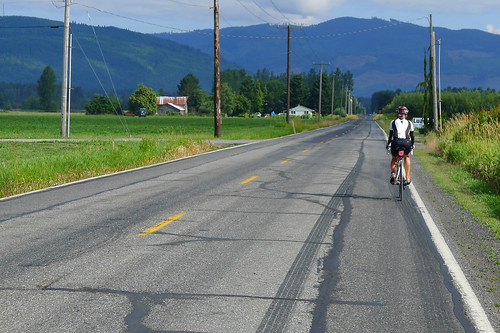
Read all the posts about this trip in backwards order (or better yet, start at the bottom and work up) here.
After spending the night, (indoors no less) in Sedro-Wolly we started our morning across the street at a coffee drive through. We spoke to another cyclist who had started his ride in Montreal and was headed for the San Juan Islands, putting our heroic two-week trip into perspective. Maybe that's why we missed the first turn and added a few miles to our day.
I don't have many photos from today. I must have been worn out, or thinking I was shooting the same thing over and over. I have no photos of the nice biker bar we stopped in, or the beautiful motorcycles out front. I have no photos of the the two huge guys and one skinny dude who leapt from their pickup to push a broken down car to a safer spot. I didn't want to photograph the woman in the road holding her tiny dog that had been hit by a car, and I didn't have the nerve to take my hands off the bars to shoot the automobile traffic hell in Bellingham.
I did, however, manage to shoot the giant marshmallow ranch as we rolled by.
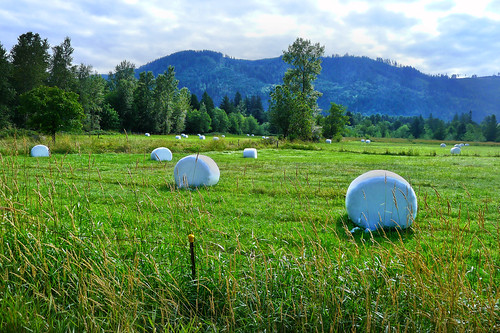
I also was greatly amused by the Napoleon Dynamite reference in a local election.
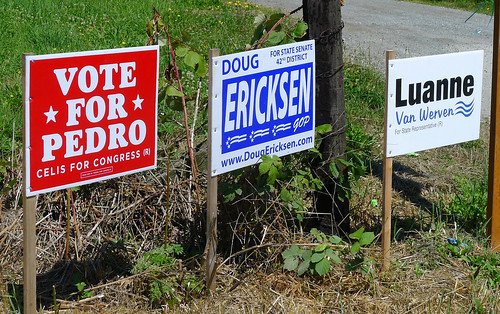
One of the things we were looking forward to was riding right up to Canadian border in Sumas to make photos.
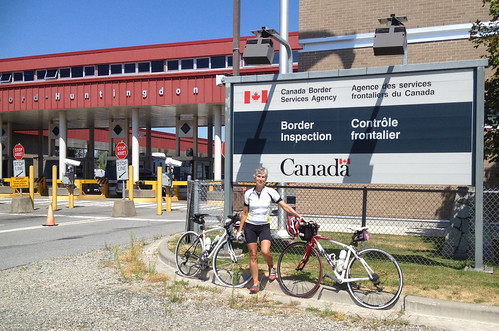
We had to snake our way through a long line of cars to get here and make our tourist photo. When we finished, being the good cycling citizens that we are, rather than ride back against traffic we crossed the street in the crosswalk well before any gates or markings, as you can see on the left of the photo. As we rolled back down the road a wildly gesticulating boarder guard yelled at us "Go back! You have to go through customs!"
We said we hadn't left the country. He asked "Did you go in the building?" and we said "No. We didn't even talk to a Canadian."
"You still have to go through customs" he announced.
Fortunately Tricia had said we should bring our passports just in case we wanted to duck into Canada for fun, so we had them in our seat bags. I think we'd still be there, or in prison, if she hadn't have had the foresight to have use pack them. When we ask our fellow riders about their experience they said they just turned around, ridden against the traffic, and had no issues. So much for our attempt to do the right thing.
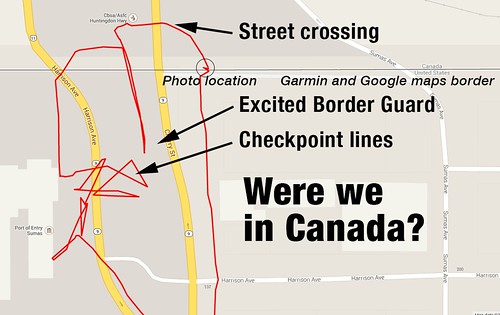
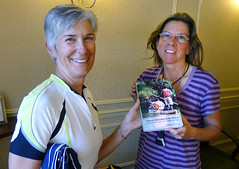 Our ride finished in Bellingham where we were directed down the busiest not-bike-friendly street ever. We totally chickened out, rode the sidewalk, and eventually arrived safely at the Best Western.
Our ride finished in Bellingham where we were directed down the busiest not-bike-friendly street ever. We totally chickened out, rode the sidewalk, and eventually arrived safely at the Best Western.Heather signed a book for Tricia, we all had dinner together and ended our Washington Cascades adventure.
This looks like the end of the story, but Tricia and I have a reflections, hints, tips and observations. If you're planning on taking an Adventure Cycling guided tour I hope you find this page, and this info helpful.
The ride
We've been on five Adventure Cycling tours before, and this was the hardest one. It wasn't the distances, it was the daily climbing. That said, I lived through it and Tricia thrived. Heather suggested people rode themselves into shape. I think I was just wearing myself out. Most of the other riders seemed to have experiences more like Tricia's than mine. So it's not like it's impossibly hard or anything. The routes were interesting and the locations stunning, and it was worth every erg of energy I spent.
Logistics
Some time after I'd signed us up I had to call Adventure Cycling and ask, "Ummm. How do we get back to the ride start?" We'd only done rides that were loops before. They explained they expected people to fly into Portland and fly out of Bellingham. Tricia and I spent a lot of time trying to figure out what to do. We ended up driving to Portland, and hiring a man to drive our car to Bellingham so we'd have it to do some visiting in Washington when we finished the ride. It cost more than I'd have liked, and the hotel charged us to leave the car parked there as well.
Eqipment
Let's face it, cycling is "stuff" oriented. Here's some stuff we used.
On our first bicycle trip we took sleeping pads that were "car camping" pads. We didn't know it when we left, but they were huge. They weighed a ton and were a pain to haul around and pack. The next time I dug up my old Thermarest self-inflating pad and Tricia bought one of her own. Size wise it was a big improvement, but they were still among the largest and ungainly items we took.
For this trip we bought Thermarest Neoair mattresses. I hated spending the money, but they are really small — less than half the size of our last pads — and very comfortable. I'd heard they were noisy to sleep on, but I didn't find it bad at all. I read the newer models were less loud, so maybe that's why.
I hate to admit it, but I am a digital guy. I took my Garmin 500 GPS bike computer, my iPhone and ... my laptop. I wanted to upload the ride data as soon as I could. The Garmin 305 I used last tour couldn't hold a week's worth of data, and I lost several interesting days on a week-long trip. I didn't want that to happen again. If I could have found a way to upload from my phone I would have skipped the computer. But there was no way. I understand the newer Garmin 510 can upload from a phone. I wish I had one.
Having two iPhones and two rear blinkie lights meant 4 USB items to charge. I bought a four-outlet USB charger that worked well, and brought a rechargeable "Powerrocks" battery charger for the phones to use when we had no outlets around.
I took my small Panasonic Lumix LX-5 camera. They're cheap now, but cost a bunch when I bought mine as the new great thing. It isn't as small as many point-and-shoots, but it has a high-quality Leica lens that's very fast, and very wide angle as well. It's taken a beating and is held together with electrical tape now, but still works. It doesn't have a very telephoto zoom, but that isn't the way my brain works, so I'm pretty happy with the camera. A lot of these photos are made on my iPhone 4S, and I'm pretty sure you can't tell which ones they are. I liked being able to post to Facebook and Instagram without having to use a computer. I'd use it all the time, but it limited by the lens, low light sensitivity and the fact it's hard to use while riding.
I took my small Panasonic Lumix LX-5 camera. They're cheap now, but cost a bunch when I bought mine as the new great thing. It isn't as small as many point-and-shoots, but it has a high-quality Leica lens that's very fast, and very wide angle as well. It's taken a beating and is held together with electrical tape now, but still works. It doesn't have a very telephoto zoom, but that isn't the way my brain works, so I'm pretty happy with the camera. A lot of these photos are made on my iPhone 4S, and I'm pretty sure you can't tell which ones they are. I liked being able to post to Facebook and Instagram without having to use a computer. I'd use it all the time, but it limited by the lens, low light sensitivity and the fact it's hard to use while riding.
Bike stuff
Tricia and I both used Sidi shoes and loved them. We use Shimano road cleats that aren't made for walking. It's not ideal, but it also wasn't a problem. We brought cleat covers to walk in, but they are a pain to haul and we ended up not using them. Experienced tourists prefer Shimano mountain SPD cleats that are much more walkable. We didn't want to buy new shoes and pedals so we went with what we knew. Not perfect, but not bad.
We took extra tires, not on the bike, but in our bags, and we're glad we did. We used two. We are fans of Park Tools tire boots as well. Read our tale about them.
Because we had days with 40 miles between water stops, we carried two large bottles each and a "Platypus" water bottle/bag. They hold half a liter and fold up very small when empty. I'd stick one in my pocket and Tricia one in her handlebar bag when we had concerns about water.
We also each used a Cygolite Hotshot 2-Watt USB Rechargeable Taillight. We'd ridden with friends in Portland who had them. We realized in areas with trees where cyclists go in and out of shadows they become hidden in the dark areas. We figured a bright little light might just save us, and it couldn't hurt. These are really bright, even in the day.
We've had our Alps Mountaineering tent several years and like it a lot. It's a four person tent, so there is tons of room. It's easy to set up, has two vestibules and a loft. It hasn't leaked or been knocked over when nearby tents have had problems.
We took clothes for hot weather and cold, as well as rain. Tricia rode in her rain pants when it was cold, but wishes she'd brought her tights as well. We wore all the clothes we brought as there were wide temperature swings. We also brought a lightweight clothesline and plastic clothespins to hang our laundry.
Tricia is a big fan of wool. She says it's comfortable, warm but not hot, as if it knows, and doesn't get smelly as fast.
Some riders rode with small panniers or camelback water carriers. We didn't want to use either, but did admire an UltraSil Daypack that weighs nothing and could be stuffed in a jersey pocket, then used to carry clothes that were shed, or (for a short distance) a bottle of wine picked up on the route. I plan to buy one.
One rider had a wonderful expanding seat bag, the nicest I've ever seen, and he was very happy with it. It isn't cheap, but I'm tempted to get one if I do another tour. Revelate Designs Viscacha.
I'm sure I'll think of 80 more things as soon as I click publish. Comment or email me me if I can answer a question. If you comment you need to tell me how to reach you!
We took clothes for hot weather and cold, as well as rain. Tricia rode in her rain pants when it was cold, but wishes she'd brought her tights as well. We wore all the clothes we brought as there were wide temperature swings. We also brought a lightweight clothesline and plastic clothespins to hang our laundry.
Tricia is a big fan of wool. She says it's comfortable, warm but not hot, as if it knows, and doesn't get smelly as fast.
Some riders rode with small panniers or camelback water carriers. We didn't want to use either, but did admire an UltraSil Daypack that weighs nothing and could be stuffed in a jersey pocket, then used to carry clothes that were shed, or (for a short distance) a bottle of wine picked up on the route. I plan to buy one.
One rider had a wonderful expanding seat bag, the nicest I've ever seen, and he was very happy with it. It isn't cheap, but I'm tempted to get one if I do another tour. Revelate Designs Viscacha.
I'm sure I'll think of 80 more things as soon as I click publish. Comment or email me me if I can answer a question. If you comment you need to tell me how to reach you!


No comments:
Post a Comment
I'm turning off comment moderation for posts younger than 60 days, so your words will appear right quick.